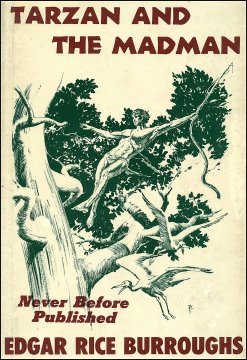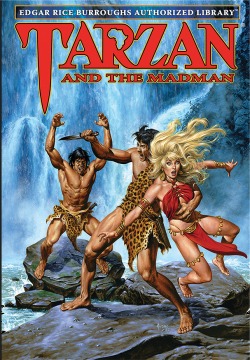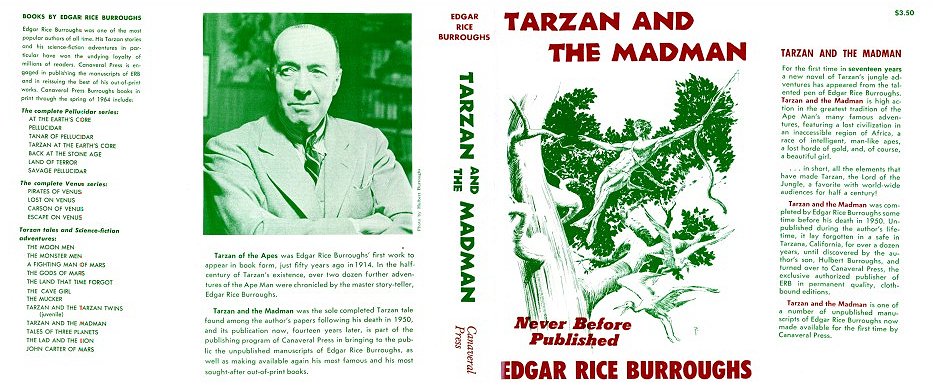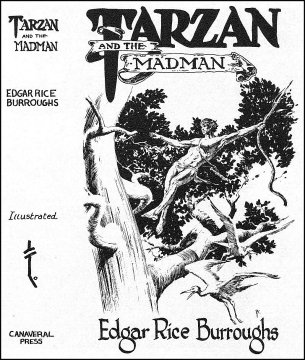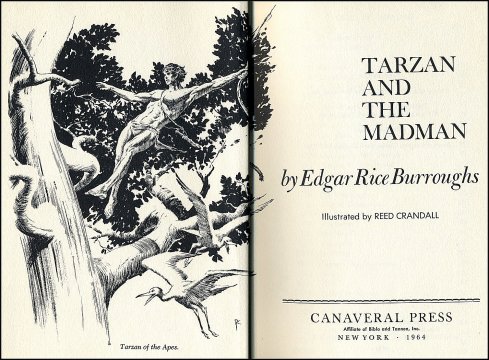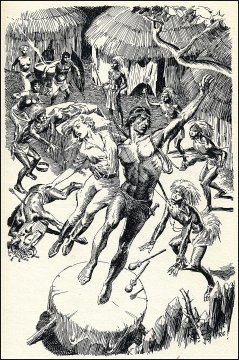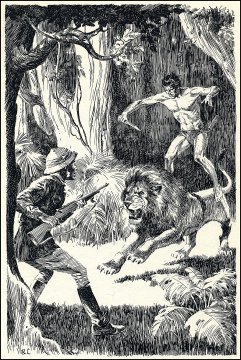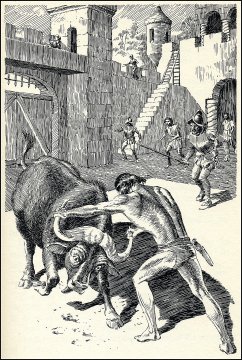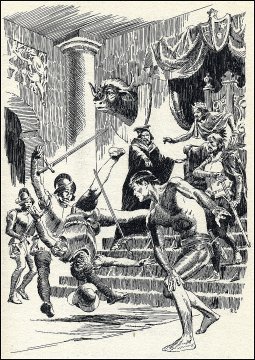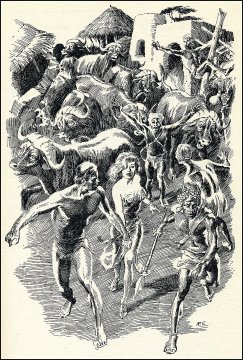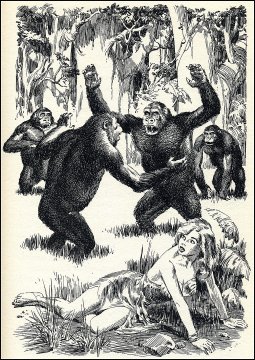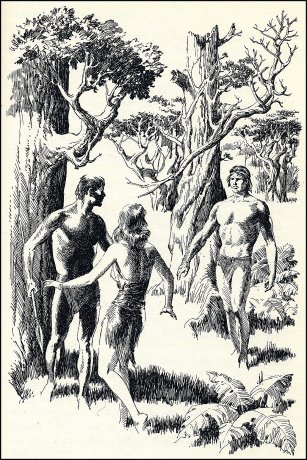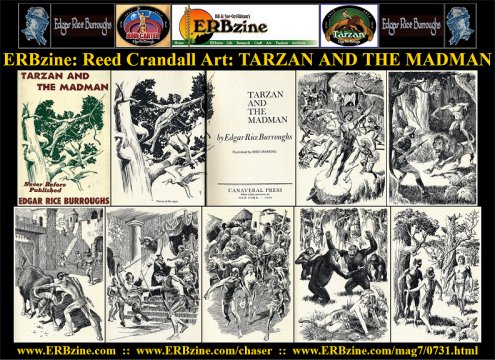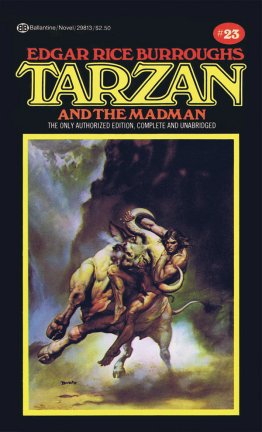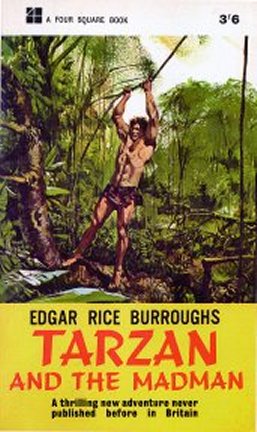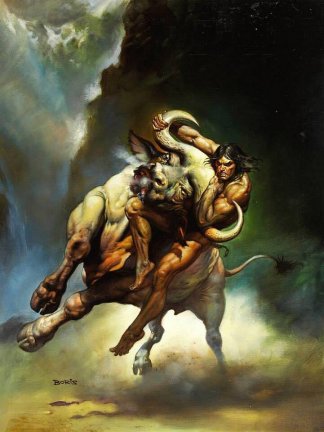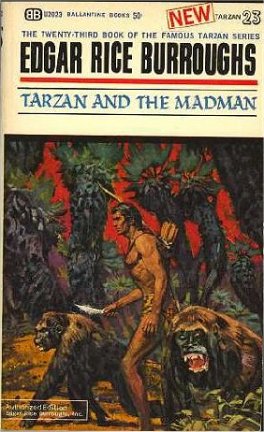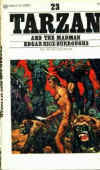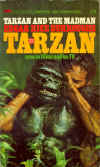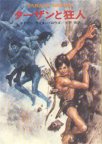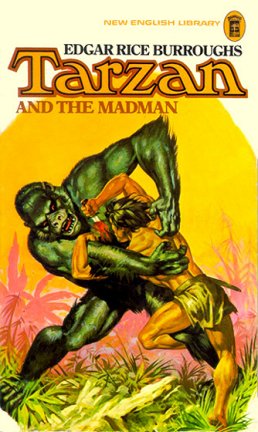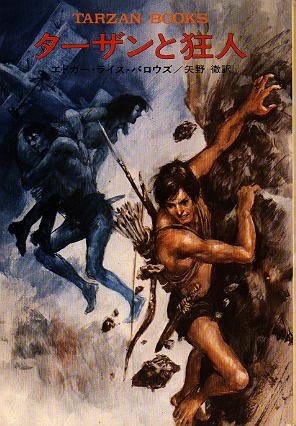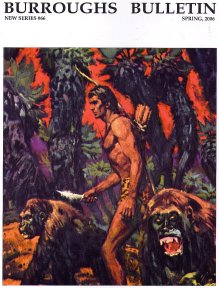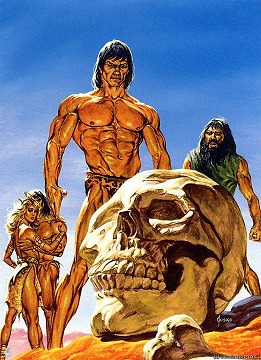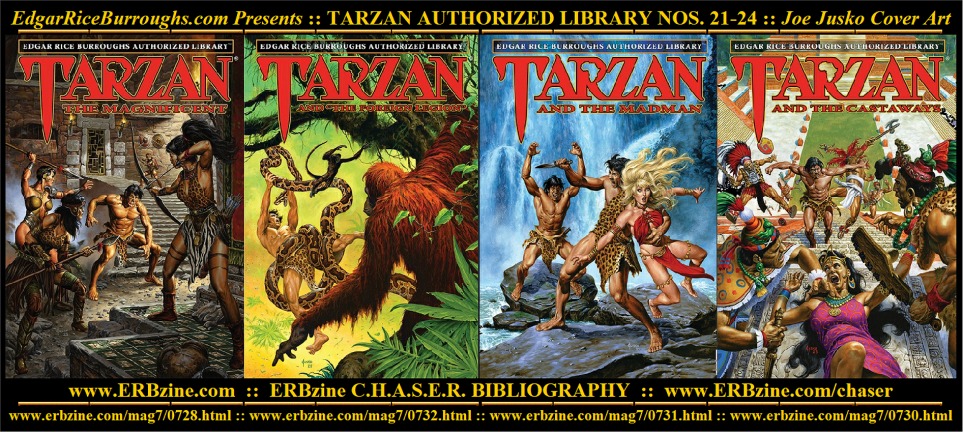TARZAN AND THE MADMAN
Review contributed by Doc
Hermes ERB Reviews
Written in 1940 but not published until 1965, this late
entry in the Tarzan series never appeared in magazine form and Burroughs
apparently shelved it for good. (The later TARZAN AND THE "FOREIGN LEGION"
also had no success in finding a magazine sale and eventually was published
by Burroughs himself, three years after it was written.) As for TARZAN
AND THE MADMAN, it was eventually brought out of limbo into hardcover in
1964 by Canaveral Press and then issued as a paperback the following year.
The book starts off strongly with the mystery of why local
friendly African tribes think the Apeman has been abducting women and children
(who are never seen again). Tarzan is puzzled and grimly determined to
find out the imposter who has been undermining his reputation (he states
bluntly that he will find the man and kill him, simple as that). There
is also an impressive moment when a crook takes a shot at the peacefully
approaching Apeman, but even as his bullet misses, an arrow thumps into
the gunman`s shoulder and Tarzan is already vanishing up into the trees.
Every now and then, we get a glimpse of just how quick and dangrous the
Apeman is, and this is one of those instances.
Unfortunately, the story quickly gets bogged down in the
confused situation involving a mysterious lunatic who thinks he IS Tarzan*
but who is believed to be God by the descendants of still another lost
city founded by Europeans long ago. This time, it`s a castle populated
by "chocolate-colored" people who are the result of Portugese colonists
who have intermixed with the native Africans, and of course they are in
a state of perpetual war with an opposing city populated by descendants
of the Moors who had been chasing the Portugese. Haven`t we seen this setup
all before? By this time, Burroughs had settled down to mixing five or
six familiar ingredients in different combinations for each Tarzan book,
and the result usually fell flat with a dull thud. Alemtejos,this particular
lost civilization, is mostly there to make some heavy handed satire about
organized religion, and since Tarzan doesn`t care particularly about the
society, neither does the reader.
The story lacks any of the supporting cast. Jane, Korak,
the Waziris are not even mentioned. For all we know, Tarzan is a solitary
creature with no family and only a casually friendly footing with some
of the native tribes. He seems oddly distracted and disinterested in the
whole proceedings, as if he is bored by the whole business and would welcome
a bash on the head so he can have amnesia again and nol have to think about
anything other than eating and sleeping. (It`s also ironic that Tarzan
scoffs at the idea of his desiring some of the treasure. "What would I
do with gold?" he asks, conveniently forgetting all the time and work he
made his Waziri tribesmen put in to looting Opar.)
Burroughs is still putting humans down and attributing
imaginary virtues to animals. He writes that animals are not avaricious
or greedy; of COURSE they are, almost every species from hummingbirds to
deer spend much of their time defending their territory or trying to extend
it, just like humans. And he repeats that animals do not lie. (Duh! If
you can`t use language, you can`t lie. And don`t you think that if your
pets could talk, that the cat would constantly be trying to blame everything
on the dog? Or that the dog would be saying some burglar must have gotten
in and eaten the steak on the dinner table?)
It`s also worth noting that while the great apes (the
word "gorilla" is never used here, as by this time the mangani were seen
as a seperate species) are happy to eat "plaintains, bananas, tender shoots
and occasionally a juicy caterpillar", they don`t mind a bit of meat now
and then. This matches what modern observors have reported and it seems
odd that Tarzan (who was raised by them) is so completely carniverous.
In every book, he pounces on a pig or deer and devours some of it before
taking off again. Seldom if ever is it mentioned that he eats fruit or
nuts. Why he doesn`t have scurvy or other nutritional deficiencies is puzzling,
unless he makes a point to eat the contents of his prey`s stomachs and
upper intestines. It would be easier to pick some fruit or shoots, but
maybe it wouldn`t be as colorful.
TARZAN AND THE MADMAN is not so much an awful book as
it is uninspired. There are some good parts, as when two treasure hunters
lugging heavy gold are dying of thirst and exhaustion but refuse to abandon
the treasure. But in general, there`s very little here we haven`t seen
before, little of the creative energy and enthusiasm that made the early
books in this series so compelling and so rewarding to read again. If there
had been a monthly Tarzan pulp magazine in the 1930s, this would probably
be regarded as an average issue; but considered as an independent book,
for which expectations would be higher, it`s disappointing. I would not
recommend it to someone wanting to try a book in the series... TARZAN THE
TERRIBLE or JUNGLE TALES OF TARZAN have much more energy and creativity,
and would give a better feel to a new reader.
*At least this guy doesn`t look like the genuine Apeman,
although they are about the same size. After Esteban Miranda and Stanley
Obroski, it would be too much to have another dude showing up who just
happens to look enough like Tarzan to fool even his wife. And the convoluted
explanation of how a man obssessed with Tarzan ends up impersonating the
real Apeman stretches your suspension of disbelief to the point where it
has trouble snapping back after the book is over.

